Following Cytokinesis In An Animal Cell, How Many Centrioles Does Each New Daughter Cell Possess?
7.3: Mitotic Phase - Mitosis and Cytokinesis
- Page ID
- 16755
Can you judge what this colorful epitome represents? Information technology shows a eukaryotic jail cell during the process of cell division. In item, the image shows the nucleus of the jail cell dividing. In eukaryotic cells, the nucleus divides earlier the cell itself splits in two; and before the nucleus divides, the cell's DNA is replicated, or copied. There must be 2 copies of the DNA so that each daughter cell will have a complete re-create of the genetic material from the parent cell. How is the replicated DNA sorted and separated so that each daughter cell gets a consummate ready of genetic material? To answer that question, you starting time demand to know more nigh Dna and the forms it takes.
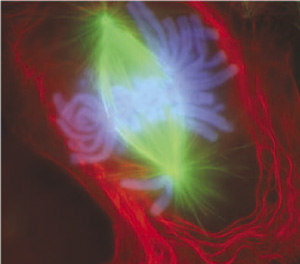
The Forms of Dna
Except when a eukaryotic cell divides, its nuclear DNA exists equally a grainy material called chromatin. Only when a prison cell is about to divide and its Dna has replicated does DNA condense and ringlet into the familiar X-shaped grade of a chromosome, like the one shown in Effigy \(\PageIndex{2}\). Because DNA has already replicated, each chromosome actually consists of ii identical copies. The two copies of a chromosome are called sister chromatids. Sister chromatids are joined together at a region chosen a centromere.
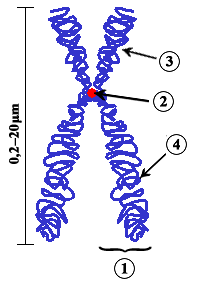
The process in which the nucleus of a eukaryotic cell divides is called mitosis. During mitosis, the ii sis chromatids that make upward each chromosome dissever from each other and movement to opposite poles of the cell. Mitosis occurs in four phases. The phases are called prophase, metaphase, anaphase, and telophase. They are shown in Figure \(\PageIndex{3}\) and described in detail below.
Prophase
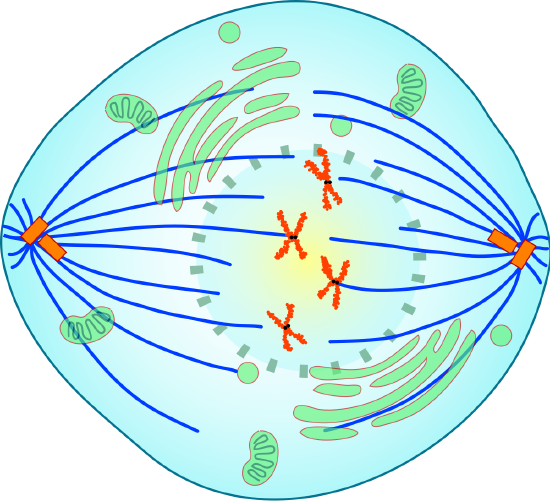
Figure \(\PageIndex{4}\): Prophase in later stage is called prometaphase. The spindle starts to course during the prophase of mitosis. The spindles first to adhere to the Kinetochores of centromeres of sister chromatids during Prometaphase.
The start and longest phase of mitosis is prophase. During prophase, chromatin condenses into chromosomes, and the nuclear envelope (the membrane surrounding the nucleus) breaks downward. In creature cells, the centrioles near the nucleus begin to divide and motility to opposite poles of the jail cell. Centrioles are small organelles constitute only in eukaryotic cells that assist ensure the new cells that form after cell partitioning each contain a complete gear up of chromosomes. Every bit the centrioles motion autonomously, a spindle starts to grade between them. The blue spindle, shown in Effigy \(\PageIndex{iv}\), consists of fibers made of microtubules.
Metaphase
During metaphase, spindle fibers fully adhere to the centromere of each pair of sister chromatids. As you can see in Figure \(\PageIndex{5}\), the sister chromatids line upwards at the equator, or center, of the cell. The spindle fibers ensure that sister chromatids volition divide and go to different daughter cells when the prison cell divides. Some spindles practise not attach to the kinetochore protein of the centromeres. These spindles are chosen non-kinetochore spindles that help in the elongation of the cell. This is visible in Effigy \(\PageIndex{v}\).
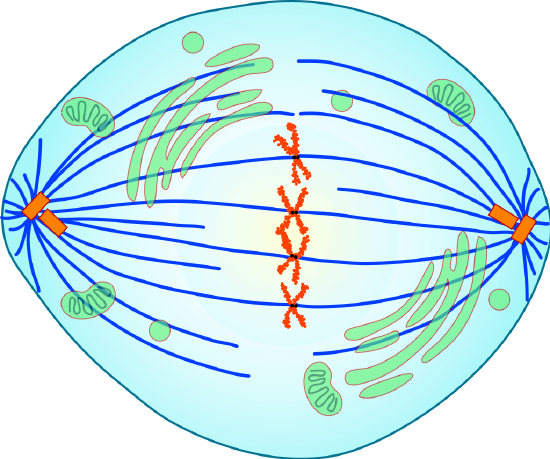
Anaphase
During anaphase, sis chromatids separate and the centromeres divide. The sister chromatids are pulled autonomously by the shortening of the spindle fibers. This is a little similar reeling in a fish by shortening the fishing line. Ane sister chromatid moves to ane pole of the jail cell, and the other sister chromatid moves to the contrary pole (come across Figure \(\PageIndex{6}\)). At the end of anaphase, each pole of the cell has a complete set of chromosomes
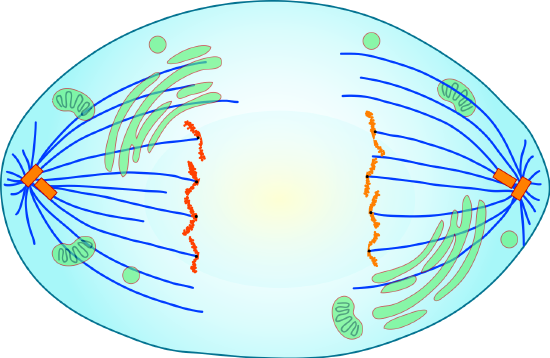
Telophase
The chromosomes reach the opposite poles and brainstorm to decondense (unravel), relaxing in one case once more into a stretched-out chromatin configuration. The mitotic spindles are depolymerized into tubulin monomers that will be used to gather cytoskeletal components for each daughter jail cell. Nuclear envelopes form effectually the chromosomes, and nucleosomes appear inside the nuclear expanse (run into Figure \(\PageIndex{7}\).
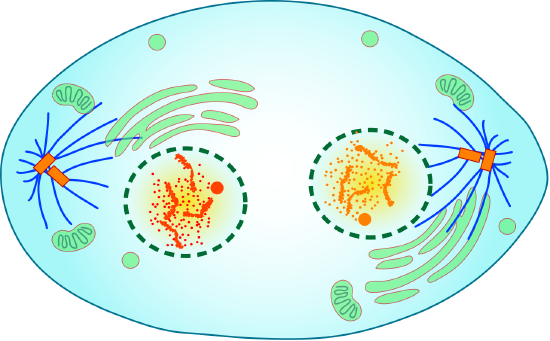
Cytokinesis
Cytokinesis is the concluding phase of jail cell division in eukaryotes as well as prokaryotes. During cytokinesis, the cytoplasm splits in two and the cell divides. The process is dissimilar in plant and animate being cells, equally you can see in Figure \(\PageIndex{eight}\). In animal cells, the plasma membrane of the parent cell pinches in along the cell's equator until two daughter cells class. In the plant cells, a jail cell plate forms along the equator of the parent jail cell. And then, a new plasma membrane and cell wall form forth each side of the cell plate.

Review
- Depict the different forms that DNA takes before and during cell division in a eukaryotic cell.
- Identify the iv phases of mitosis in an beast cell, and summarize what happens during each phase.
- Explain what happens during cytokinesis in an animal cell.
- What are the primary differences between mitosis and cytokinesis?
- The familiar X-shaped chromosome represents:
- How DNA always looks in eukaryotic cells
- How Dna in eukaryotic cells looks once it is replicated and the prison cell is about to carve up
- Female sex chromosomes only
- How DNA appears immediately after cytokinesis
- Which of the following is not part of a chromosome in eukaryotic cells?
- Centriole
- Centromere
- Chromatid
- Dna
- What do y'all think would happen if the sis chromatids of one of the chromosomes did non separate during mitosis?
- Put the following processes in social club of when they occur during cell sectionalization, from first to last:
- separation of sister chromatids
- Deoxyribonucleic acid replication
- cytokinesis
- lining up of chromosomes in the center of the prison cell
- condensation and coiling of DNA into a chromosome
- Why do you call back the nuclear envelope breaks down at the start of mitosis?
- What are the fibers made of microtubules that attach to the centromeres during mitosis are chosen?
- True or False. Chromosomes begin to uncoil during anaphase.
- Truthful or Imitation. During cytokinesis in animate being cells, sis chromatids line up forth the equator of the jail cell.
- True or False. Later on mitosis, the consequence is typically two daughter cells with identical Dna to each other.
Explore More
Source: https://bio.libretexts.org/Bookshelves/Human_Biology/Book:_Human_Biology_%28Wakim_and_Grewal%29/07:_Cell_Reproduction/7.3:_Mitotic_Phase_-_Mitosis_and_Cytokinesis
Posted by: reyesaffir1968.blogspot.com



0 Response to "Following Cytokinesis In An Animal Cell, How Many Centrioles Does Each New Daughter Cell Possess?"
Post a Comment